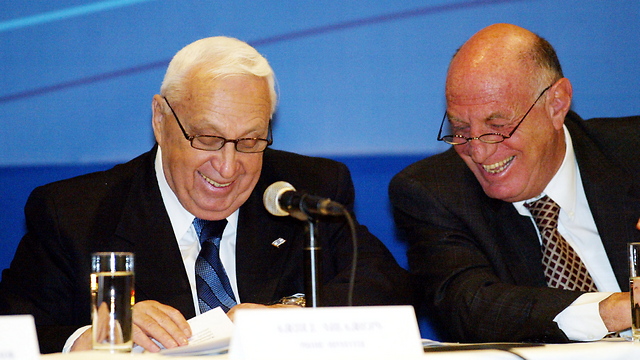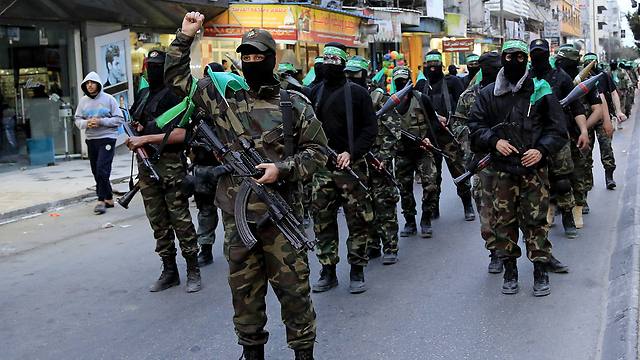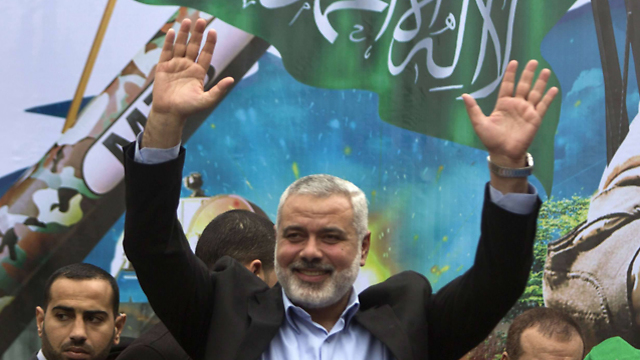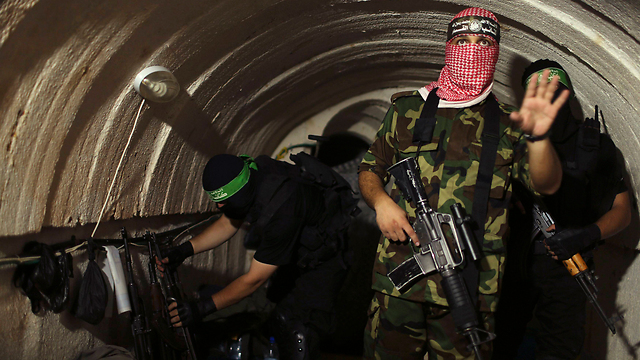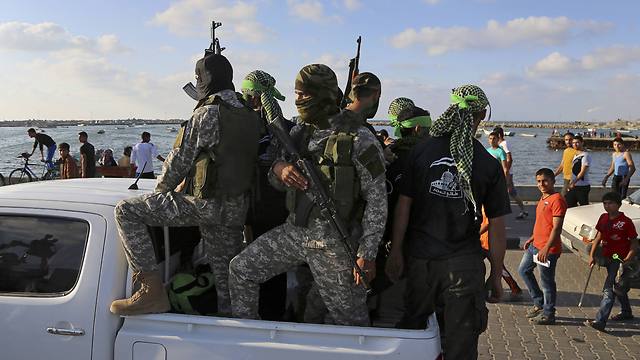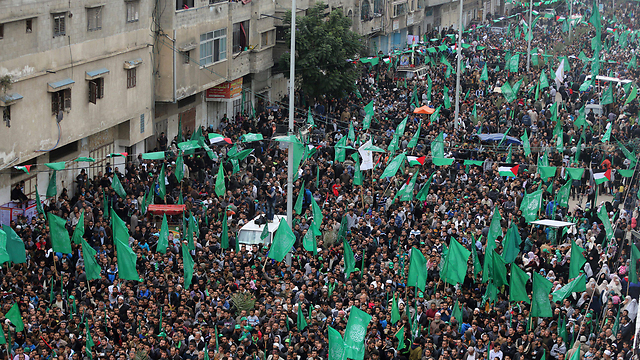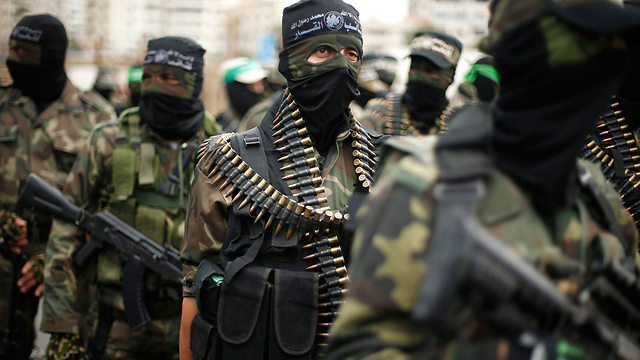
How IDF Intelligence failed to predict 'Hamastan' in Gaza following Israeli pullot
A year before the evacuation, the Southern Command warned of 'Hamastan in Gaza,' but Army Intelligence was quick to dismiss it, while the Shin Bet estimated Hamas was interested in calm; those who did try to alert of the dangers of leaving Gaza were pushed aside, while the rest toed the line.
The first time the GOC Southern Command, Dan Harel, heard about the plan to evacuate Jewish settlements in the Gaza Strip was on the radio, while driving his car. This was in December 2003. He was listening to prime minister Ariel Sharon's speech at the Herzliya Conference when he suddenly realized that a dramatic decision has been made in secret and without his knowledge, and that one of the most meaningful events the Israeli society and the IDF will ever experience was going to happen under his command.
The research division at Army Intelligence, which was supposed to provide the intelligence for the Gaza disengagement, was also unaware of what was happening in the prime minister's close circle.
It is not unreasonable to assume that the prime minister and defense minister would be interested in hearing the opinion of Army Intelligence officials on what are the security consequences such an unprecedented move. But even the head of the research division at the time, Brig.-Gen. Yossi Kuperwasser, heard about the disengagement for the first time only when it was already a done deal.
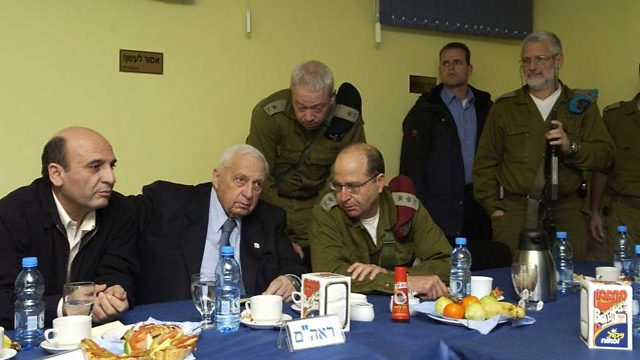
This happened during a meeting held by the prime minister's chief of staff, Attorney Dov Weissglass, who was Sharon's negotiator with the Palestinians. The decision was presented in that meeting as a done deal, and none of those in attendance - senior Shin Bet and IDF officials - were asked for their opinion on the topic.
The IDF was no more than an executing contractor, according to one of the generals who participated in the discussions about the Gaza disengagement.
The top echelons of the army quickly got used to the fact their opinion did not interest anyone among the political leadership and that they hold no sway or influence on the decision.
Army Intelligence and the Operations Directorate's analysis of what could happen on the Gaza front after the Israeli withdrawal focused mostly on the advantages of such a move. If there were any who thought otherwise in the army, they kept quiet. Especially in public.
The IDF's chief at the time, Moshe Ya'alon, whose term was cut short three months before the disengagement from Gaza, knew a little bit more than his generals. During one of the meetings he had with Sharon, shortly before his speech at the Herzliya Conference, the prime minister presented him with an idea he heard from minister Tommy Lapid.

In an attempt to create a diplomatic initiative and end the diplomatic freeze ahead of the implementation of the American road map for peace that was on the table at the time, Lapid proposed to evacuate three settlements in the Gaza Strip. Ya'alon could not have known that behind this "small plan" was a much bigger plan. Sharon, it seemed, just wanted to test the waters with the IDF chief. At the time, they talked about two or three Jewish settlements on the northern border of the Gaza Strip - Nisanit, Dugit and Elei Sinai.
Ya'alon rejected the idea out of hand. A withdrawal, he claimed, will encourage jihadist groups. Later, Ya'alon was quoted as saying that the disengagement from Gaza will provide a "tailwind" for terrorism, which did not make him any more popular in the Prime Minister's Office.
Then-defense minister, Shaul Mofaz, supported the disengagement, but did not take part in the prime minister's intimate consultations with his close allies. Several days before the Herzliya Conference, Sharon updated Mofaz in a phone call about his intention to present the disengagement initiative at the conference. Sharon was really checking whether Mofaz would remain by his side during the move.
Cold shoulder from Ya'alon
A decade later, the memory of the "executing contractors" - the IDF chief of staff, army generals, Army Intelligence officials and others - is growing dim. But one thing is clearly remembered by all: The army was not a real partner in the decision-making process. What the political leadership was interested in, and this was the army's main role, was the physical evacuation of the settlements. The IDF was not really asked to present to the political leadership with its assessments of the expected security situation in the area as a result of the disengagement, both on the medium and long-term.Now, these high-ranked officials maintain that Sharon did not include them in the decision-making process both because he was afraid of leaks, and because he was afraid of private and public opposition from the army, which could have sabotaged the evacuation plan.
The security cabinet itself was not a full partner in the decision-making process either. Sharon worked with several close advisors - which at the time were referred to as "The Ranch Forum" - and used to have private consultations with a very small group of people, among them some from the military. One of them was Brig.-Gen. Eival Gilady, then the head of the strategic planning division in the Planning Directorate. Weissglass also held meetings with army officials from the Planning Directorate and Army Intelligence. But near the end of 2004, chief of staff Ya'alon barred these officers from showing up to these meetings, because he considered them a manipulative political forum in which the army had no place.
The relations between Weissglass and the chief of staff were already murky and difficult by that point. While the PMO viewed Ya'alon as a "strange bird" who could only get in the way, the chief of staff's office suspected Weissglass was turning the prime minister against Ya'alon. Brig.-Gen. Gilady, who continued having direct communications with the prime minister, got the cold shoulder from Ya'alon.
After the Herzliya speech, in December 2003, defense minister Mofaz met with chief of staff Ya'alon on the evacuation plan. It was clear to both of them that evacuating three settlements was neither here nor there. The defense minister thought it made more sense to evacuate all of the Jewish settlements in Gaza.
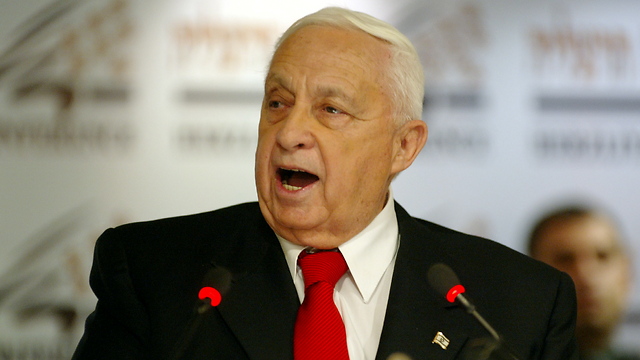
At the time, the prime minister and defense minister received a "map of national security interests" prepared by the Planning Directorate during Yitzhak Rabin's premiership. According to this document, Israel's clear security interests were in the West Bank, and there was no room for negotiations there. In the Gaza Strip, however, the situation was reverse.
In Gaza, there was no way to improve the security situation, because the IDF was not in control of the entire Strip, and there was only one division there to protect the settlers.
The working assumption was that as soon as the Gaza Strip is evacuated, not only could the army cut the number of troops in the area by a third, but the border itself will be calmer.
Furthermore, the defense establishment asserted, an IDF pullout from the Strip will give Israel the freedom to hit Gaza harder if the Palestinian Authority fails to control the rebellious organizations in the Strip.
2004 was the first year in which the number of Israeli casualties in Gaza was higher than in the West Bank. Hundreds of Qassam rockets were fired from the Strip, half of which fell in Sderot. In addition, some 3,000 mortar shells were fired at Jewish settlements inside the Gaza Strip and communities on the border.
During a situation assessment, the IDF said that following the disengagement, Hamas will have an interest to maintain the calm in Gaza. Any escalation against Hamas, the IDF believed, will happen in the West Bank or inside Israel. The belief was that after the disengagement, Hamas would view the West Bank as its center of operations, and it will have no interest to drag the IDF back into the Gaza Strip. It was enough for the IDF to defend the Gaza border properly for relative calm to be maintained.
All of this, of course, depended on whether or not the evacuation would go ahead as planned. For a long time, the top echelons of the army believed nothing would come out of this plan. At first, the disengagement imitative was viewed as Sharon testing the waters. Later, the army believed the plan will not go ahead because of political reasons. Maybe that is why the IDF and Shin Bet did not feel any urgency, and did not see the need to discuss the long-term processes that would happen in Gaza after the IDF withdraws. The heads of the IDF also don't remember ever being called to a cabinet meeting on what is expected to happen in Gaza the day after the withdrawal.
It was only in February 2005, when the Disengagement Plan Implementation Law was passed in the Knesset, that the heads of the defense establishment realized there was no way back anymore. This was also when Ya'alon's replacement as IDF chief was announced: Dan Halutz.
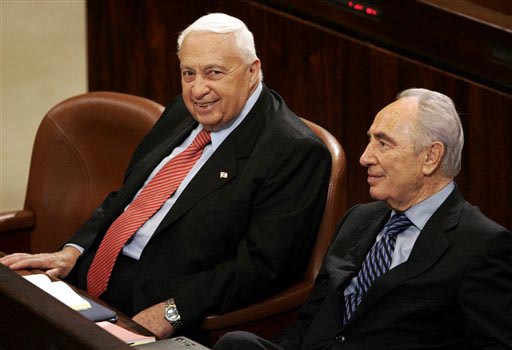
In early February 2004, Haaretz journalist Yoel Marcus wrote about a conversation he had with Sharon in which the prime minister talked about a full disengagement from the Gaza Strip. After reading this article, chief of staff Ya'alon sent a letter to the prime minister, which was followed by a tense meeting between the two. Ya'alon complained that the army was not included, that there was no administrative work done, and that all of this was unacceptable. Sharon blew him off, and promised to have a meeting on the topic as soon as possible.
It happened two months later. Prime minister Sharon, defense minister Mofaz, chief of staff Ya'alon, Shin Bet chief Avi Dichter, Planning Directorate head Yitzhak Harel, Army Intelligence chief Aharon Ze'evi-Farkash and others were all present in the meeting. This was actually the first meeting in which the disengagement plan was formally presented and that included a discussion about the repercussions of this plan. Sharon informed those present that the evacuation of the Gaza Strip will be done within a year. This was the first real fall out between Sharon and Ya'alon. The chief of staff claimed withdrawing from the Gaza Strip when Islamist groups were on the defensive internationally was a fatal error that could change this trend.
Several weeks after that discussion, the defense minister and chief of staff received a document from GOC Southern Command Dan Harel titled "Hamastan in Gaza." The document, which analyzed the security developments that are expected in the Gaza Strip following the disengagement, raised the possibility that Hamas would take over the Strip and that the disengagement would not lead to the long sought for calm. An argument broke out in the General Staff, and the Southern Command received response documents from Army Intelligence which rejected that thesis.
The Southern Command officers who wrote the document now admit that it did not include a clear prediction that Hamas would take over Gaza in a military campaign, and that the Strip will turn into a main center of fighting against Israel. The concept of "Hamastan" was included in the military discussion, but the document ended up becoming an episode that changed nothing. No one doubted the fact the Southern Command would execute any order it received.
During a government meeting in June 2004, the heads of Israel's intelligence community estimated that the move would improve the security situation in the south. Army Intelligence chief Ze'evi-Farkash said at that meeting that "The disengagement will decrease terrorism and make it bearable."
Shin Bet chief Avi Dichter predicted the unilateral move "will lead to a decrease in the number terrorist attacks and change their pattern."
Another argument that arose later was whether to evacuate the Gaza Strip but leave IDF presence along the Philadelphi Route on the Egyptian border to strop smuggling, as well as leaving the northern border settlements Nisanit, Dugit and Elei Sinai. In both cases, it was decided to withdraw. The decision on the Philadelphi Route was made a day before the beginning of the evacuation in August 2005. Sharon was against it, but the legal advisers explained to him he could not announce a pullout from the Strip while remaining in Philadelphi.
Back then, even before the disengagement, Army Intelligence had information about tunnels that were being dug near IDF posts on the Gaza border. Military reporters were specifically told in briefings that this trend was growing and that there was digging in the direction of Hoover's Axis, which surrounds the Gaza Strip. Shortly before the disengagement, Israeli officials estimated there were over ten tunnels in front of Hoover's Axis. Less than a year after the disengagement, Gilad Shalit was kidnapped through one of these tunnels.
Work accident
The IDF completed the evacuation of the Gaza Strip on September 11, 2005. On September 23, Hamas held a "victory parade" at the Jabalia refugee camp, during which a Qassam rocket fell off a vehicle, blew up in the crowds and caused secondary explosions of ammunition and other weapons. Over 20 Palestinians were killed and dozens injured.
Even though this was a work accident, Hamas blamed Israel and vowed revenge. That very night, less than a week after the end of the disengagement, a heavy barrage of rockets was fired at Sderot and the rocket fire did not stop for two days.
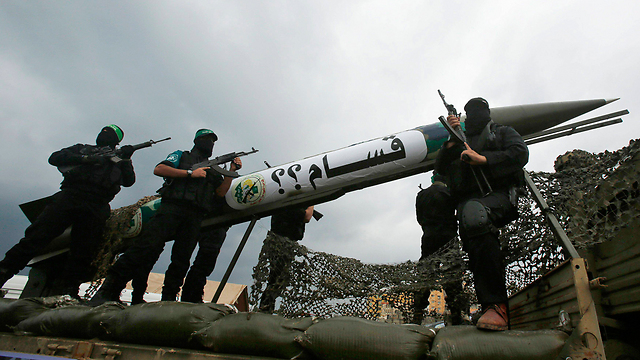
The IDF responded late, in what was code-named "Operation First Rain," and included mostly airstrikes. The government was criticized for avoiding a significant response.
All of this did not make Israeli security officials, including the Shin Bet, change their situation assessment from the eve of the disengagement. Two months after the end of the disengagement, in November 2005, G., the head of the Shin Bet's southern district, said in a private conversation that "so long as we encourage Abbas' rule, we don't perceive the smuggling of weapons into the Palestinian Authority as a threat ... the control over the Philadelphi Route collapsed when Israel withdrew, now the situation is stabilizing, even though there are incidents of bribes given to both Palestinian officers and to Egypt."
What bothered the Shin Bet at the time was terrorists leaving Gaza through the Sinai Peninsula to commit attacks in the Negev, and the concern the Palestinians move their terror activity from Gaza to the West Bank.
That month, the incoming GOC Southern Command, Yoav Galant, told military reporters: "Israel's withdrawal from Gaza did not significantly change the balance of power inside the Gaza Strip. The withdrawal from the Philadelphi Route created a situation of a less moderate border than Israel initially estimated. Hamas took 55 percent of the votes in municipal elections in the Gaza Strip and shocked Fatah. The belief is that Hamas will be included in the political system, but that this is a self-disciplined organization and the decision to take over the Strip is not one made by Hamas' military wing."
In February 2007, a year and a half after the disengagement, Shin Bet chief Yuval Diskin spoke of the passing year. He spoke about the disintegration of the Palestinian Authority, mostly in Gaza, and about Fatah's war for survival, which he believed will motivate its people to fight.
And then he also determined: "Hamas is interested in calm. For Hamas, a government is not the main thing. Hamas is incapable of governing."
He went on to say that "We don't have a proper response to the steep-trajectory rocket fire from the Gaza Strip. If it continues and there is no Palestinian group to stop it, Israel will be forced to go back into the Gaza Strip. At the moment, there's no room for Israel to intervene, as Fatah is still the dominant group against the fundamentalists and we shouldn't get in the way."
In the same briefing, the Shin Bet chief said that in 2006, Hamas smuggled 30 tons of explosives through the tunnels along the Philadelphi Route - compared to 5 tons of working explosives in 2005 and only one ton in 2004.
Less than four months after the Shin Bet's prediction, the very same Hamas, that "doesn't want to take power," forcibly took over the Gaza Strip, ousted the Palestinian Authority and formed a government.
Even on the day the military coup in Gaza started - June 12, 2007 - the Shin Bet's research division estimated this was a violent outburst caused by the tensions between Hamas and Fatah, not something that would lead to Hamas' military wing seizing power.
Even before the disengagement, Israeli officials realized Fatah was slowly losing control while Hamas was only growing stronger in Gaza. But no on predicted Hamas' full takeover of Gaza and the Strip becoming a central threat to Israel. Even chief of staff Ya'alon, who believed the disengagement was a mistake, estimated in 2004 that the State of Israel was facing a strategic turn in its ties with the Palestinians: Arafat was dead, a new Palestinian president who opposes terrorism was appointed, the US was facing elections and there was an Israeli plan for a disengagement - so Abbas needed to be bolstered and allowed to take over the Strip.
Even Sharon thought Israel should help Abbas take over Gaza, and he even met with him. In a briefing with reporters in February 2005, Sharon said: "I am not a diplomat, I'm a farmer, and I won't leave anything unclear. We need to help Abbas. I said I was ready to help him and I'm helping him. We helped him during Arafat's illness and burial and during the elections."
At the end of the day, the disengagement was a political-diplomatic move. Sharon was willing to take security risks and that is why the IDF was only included in the execution and not in the decision-making process. The top military echelons quickly toed the line and provided the political leadership with the "right" security reasoning. The authority Maj.-Gen. (res.) Sharon had in matters of security was crucial.
The inability of Israel's security forces to correctly assess the diplomatic and military developments that would occur in the Strip after the disengagement should not surprise anyone. Army Intelligence has a built-in handicap in their ability to predict major social or diplomatic processes. Army Intelligence could never replace the cabinet, prime minister and defense minister's experience and thinking process. On the eve of the disengagement, Army Intelligence was not required to provide – nor did it – any strategic warning on the possibility of a terror entity rising to power in Gaza.
Since the establishment of that Hamastan in Gaza, it forced a continuous unrest on Israel, international de-legitimization, enormous investment of money and resources, and, above all, four large-scale military operations. Hamas' military capabilities can reach north of the Tel Aviv area now, and the group continues growing stronger. Gaza has turned into a real front, which will occupy large IDF forces even during confrontations on other fronts, like Lebanon.










